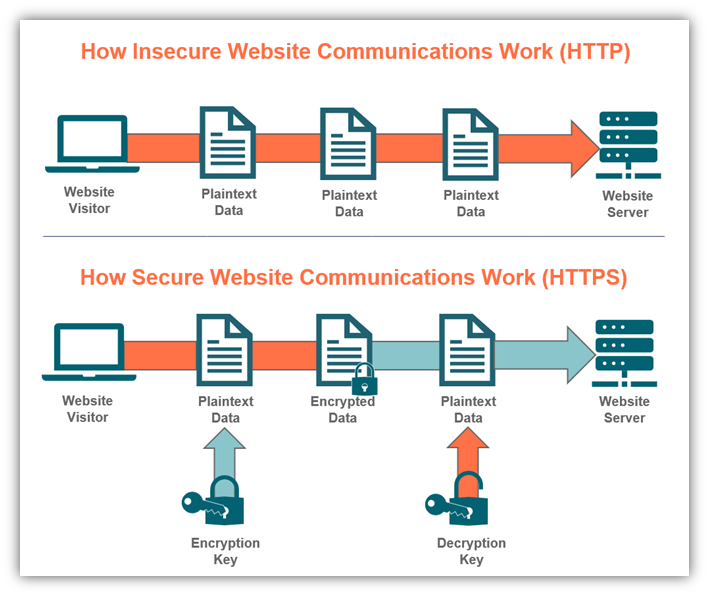Everyone, including tech giants like Google and Mozilla, is rooting for secured websites with the prefix HTTPS instead of HTTP. However, the question arises “what is HTTP vs HTTPS?” and “what is the difference between these protocols?”
What is HTTP vs HTTPS? Well, we could say that they’re two related but distinct internet protocols, but that wouldn’t do you much good and would make for a really short, boring article. So, we’ll take a little more time to really break things down for you. This article will discuss the difference between HTTP and HTTPS, why understanding HTTP vs HTTPS security matters, and what the advantages are of using one protocol over the other.
HTTP vs HTTPS Security
In a nutshell, “HTTP vs HTTPS” is the difference between providing a secure, encrypted connection to your website and not choosing to do so. The former (HTTP) is an insecure way of communicating via the internet, whereas the latter (HTTPS) is not. In a basic sense, HTTPS as the new-and-improved version of HTTP… but there are technical differences that further distinguish them.

Understanding the difference between HTTP and HTTPS is important because of the weight search engines place upon using secure connections. For example, Google and Mozilla include the security of websites as a ranking factor for their search results. And since 2018, all major browsers have made it where their platforms scream “Not Secure” whenever someone accesses a website that lacks a trusted digital certificate (i.e., an SSL or TLS certificate, which we’ll talk more about later).
Credit card companies and other regulatory bodies have also declared war against sites that are not secure. (Think PCI DSS, HIPAA, GDPR, CCPA, etc.) If you aren’t compliant with their requirements, you could face steep penalties. And since virtually everyone is moving toward forcing you to have “HTTPS” for your website, it’s obvious you want to know the difference between HTTP and HTTPS.
Let’s look at both HTTP and HTTPS more in-depth to gain a greater understanding of the topic at hand.
What Is HTTP?
HTTP stands for hypertext transfer protocol and is an application layer protocol. In website security, it’s a protocol that allows servers and clients to communicate via the internet. It’s considered a stateless system because it provides on-demand connections to browsers that initiate them. Oh, and also want to quickly mention that HTTP is the predecessor of HTTPS. (We’ll speak more to that shortly.)
To exchange data packets over the internet, HTTP relies on TCP (transmission control protocol) principally via port 80. After the initial handshake with the client and the server, the HTTP server will use different kinds of request messages, including:
- Post,
- Get,
- Head, and
- Connections.
Of course, there are others as well. In fact, the latest version of HTTP uses nine types of request methods. But I think you get the point.
HTTP Is an Insecure Way to Communicate Data
The biggest issue with an HTTP website is that it does not offer secure communication (meaning that data is unencrypted and transmitted in plaintext format). While using an HTTP site, your data can be hacked, stolen or manipulated by attackers. Not too long ago, many websites used HTTP and switched to HTTPS on the payment page. However, this situation is changing (thankfully) — and fast (though not fast enough).
Nowadays, most sites use the secure version of HTTP called HTTPS. The move from HTTP to HTTPS was instigated by the creation of SSL, or what’s known as the secure sockets layer. Of course, as with all things in life, nothing ever lasts or stays the same. The same is true with SSL. The SSL protocol went through multiple iterations, all the way up to SSL version 3.0, before it was eventually replaced by its new successor, transport layer security (TLS).
Of course, we’ve moved on through a few versions of TLS as well and are now on TLS version 1.3. However, it’s important to note that the majority of websites (99.3% as of February 2021) support TLS 1.2 and only 42.9% support TLS 1.3, according to data from the SSL Labs dashboard.
Just a quick note, though, to try to help you keep things straight in your head: Although TLS has replaced SSL, and even though there are some technical differences between the two protocols, people in our industry still refer to both as “SSL.”
This is particularly the case when people are talking about SSL/TLS certificates. So even though you’re technically purchasing a TLS certificate, people will typically still call it an SSL certificate or an SSL/TSL certificate.
What It Looks Like When Websites Use HTTP
Well, let’s just say that a website using HTTP doesn’t make for a pretty picture. You see, web browsers don’t like websites that use this insecure protocol. In fact, they specifically warn users when websites are insecure by publishing scary messages and warning symbols.
For example, the following screenshot shows how Google Chrome marks an HTTP site as “Not Secure.”

Now, put yourself in the shoes of your customers. Does seeing a warning message like this inspire confidence in the notion that this website is a secure place to shop or share any type of personal data? I think not. This can result in lost business and driving your customers straight into the arms of your competitors who have secure websites!
But there is good news that stems from this knowledge. There’s a way you can prevent this type of message from appearing on your site: by serving up your website via the secure HTTPS protocol instead of using HTTP.
What Is HTTPS?
HTTPS, or hypertext transfer protocol secure, is basically the newer, more secure version of its predecessor. HTTPS is also sometimes called HTTP over TLS and it uses port 443 instead of port 80.
While comparing HTTP vs HTTPS security, the latter scores the highest points without a doubt. Why? Because when you enable HTTPS on your site properly, the communication that takes place between a client and your server is encrypted. This means that nosy busybodies can’t intercept or mess with your data while it’s in transit. And, regardless of whether users access your website from their laptops or their mobile devices, HTTPS protects the traffic on both!
A really important differentiator between HTTP and HTTPS that we have to mention here is that HTTPS relies on public key infrastructure (PKI) to do its thing.
Public key infrastructure is the underlying complex world of technologies and processes that makes secure internet communications possible. It’s an entire ecosystem that consists of multiple essential components, which include (but are not limited to):
- X.509 digital certificates — this includes SSL/TLS certificates, email signing certificates, code signing certificates, document signing certificates, etc.).
- Cryptographic key pairs — this includes both public and private keys.
- Certificate authorities (CAs) — the trusted third parties who are responsible for issuing the certificates and meeting industry standards.
Not sure why you should care about PKI? Let me ask you this; Do you like being able to order takeout or make late-night Amazon purchases online in a secure way? Then you can thank PKI for that!
HTTPS Requires SSL/TLS Certificates
We’ve touched on this a little bit but we’re going to reiterate it here: enabling HTTPS requires the use of a valid SSL/TLS certificate. This digital certificate is a file that contains information about your organization to help it authenticate as well as other nifty cryptographic information that helps site users communicate with it securely through encryption.
SSL/TLS certificates come in a variety of options and validation types that meet your needs.
- Domain validation (DV) — This only requires the site owner to prove they own the domain. It’s the lowest level of verification and is best for sites that don’t collect user information or require them to log in.
- Organization validation (OV) —This level of validation is more rigorous than DV but not as in-depth as the next type of validation we’ll list. OV validation is great for websites that want to assert their identity and offer data security.
- Extended validation (EV) — This type of validation is the most stringent and requires the highest level of verification by the issuing CA. As a result, your organization information displays more prominently. This is best for websites that collect and need to protect users’ sensitive information.
Before the server and the client start their conversation, they must first exchange information and keys in a process known as an SSL/TLS handshake. This process results in creating another key (a session key) that the two parties secretly decide upon. This key is what they use to establish the secure, encrypted connection that will be used for the rest of the session.
Without HTTPS, the data transfer will not be encrypted. This means that any data that the client send to the server will transmit as plaintext, and anyone who intercepts the conversation will be able to read and use this data for malicious purposes. (This is known as a man-in-the-middle attack, or MitM). This means that everything that you enter on the site — from your personal information and credit card information to your login credentials — will be open to compromise.
What It Looks Like When You Use HTTPS
So, what does it look like when you have an SSL/TLS certificate installed on your website? Secure. Not scary or worrisome. You see a comforting security padlock icon in your web browser that tells you that your data is transmitting securely. Much better than a “Not Secure” message, am I right?

What’s especially great about it is that you can click on that icon to pull up additional information about the certificate and, depending on the certificate’s level of validation, information about the organization operating the site.
HTTPS or HTTP: Which Is Better?
Why switch to HTTPS when HTTP had been “good enough” for all these years? Is the switch and the cost of the switch worth the time and efforts? What makes HTTPS much reliable than HTTP? Why should you buy an SSL certificate? Well, you will get your answers when we compare both the protocols and show you the benefits of https.
HTTPS Provides Additional Security
As the name suggests, HTTPS is far more secure than HTTP. The SSL/TLS certificate helps you to safeguard the data while it’s in transit between your website and the client. When data travels across the internet, it bounces between a lot of servers before it reaches its final destination. That’s a lot of opportunities for cybercriminals to compromise it.
And if you’re using a certificate that validates your identity, it’ll also give assurance of your site’s authenticity so users know they can trust their data is secure. This also helps you make your site stand out from imposter (phishing) websites.
HTTPS Helps Your Site to Avoid Displaying Ugly “Not Secure” Messages
As we mentioned earlier, no one likes to see warning messages on websites that scream “this website is secure — run away!” But that’s basically what happens when you use the insecure HTTP protocol on your website instead of the secure HTTPS protocol.

“Not Secure” as is obvious suggests that the connection between the two devices is not secure. This implies that anybody watching the connection can easily watch what is being transferred, including login credentials, social security numbers, and credit card numbers.
HTTP sends data over port 80, while HTTPS sends data over port 443. HTTP only operates at application layer, but HTTPS operates at transport layer and uses PKI technologies and processes. These technical differences are a part of security protocol that make HTTP website “Not Secure.”
HTTPS Increases Trust Through Identity
When the visitor of your website reads the “HTTPS” on your website with a padlock, he will be able to trust that the connection with your website is secure and that no one will be able to intercept it. As we mentioned a moment ago, most consumers will not purchase from your website if they see “HTTP” and a “Not Secure” warning on their screen. And why should they? Having that message on your site communicates that you apparently don’t care about their security!
One of the most effective ways to woo consumers is to guarantee the security of their data. But there is a difference between being secure and being safe. Using encryption to secure data is one thing, but it doesn’t do users any good if they don’t know who is receiving their data on the other end. And this is why your organization’s digital identity matters.
Having an ecommerce business is very different from running a brick-and-mortar store. When you do business online, you don’t necessarily know your customers personally — and, more importantly, they don’t know you. As such, in some ways, these dealings are between two strangers. In this situation, it becomes necessary for a reputable and trusted third party to assure users (and their web client/browsers) that you are a genuine business owner who has a good reputation and is trustworthy.
The best way to help people know who they’re really talking to is by asserting your identity through verifiable means. This is where using OV or EV certificates can really come in handy. Before a CA can issue an SSL/TLS certificate, they have to spend days checking your business to make sure it’s legitimate. This requires comparing information the site owner provides against a variety of official third-party sources and using other verification methods. And only once they’re certain your business is legitimate will they issue a certificate for your site.
HTTPS Improves Your Website’s Google Search Engine Ranking
Ranking on search engines is crucial for any website. When a visitor types in his query on a search engine, the search engine will rank the websites using many different factors. The first organic result in Google search has the highest click-through rate of the 28.5%, based on a Search Engine Journal report. The second and third result has the rate of 15% and 11% respectively, and it plummets to a measly 2.5% for the 10th result.
Hence, you should do everything you can to improve your search engine ranking. Having an SSL certificate and HTTPS before your website address is something you can do to achieve that target.
Having HTTPS Protects You From PCI/DSS Penalties
The Payment Card Industry Data Security Standard (PCI DSS) is an information security standard that businesses who accept the payment via any major credit card must follow. If you fail to follow the protocols, then you can be penalized and face heavy fines to credit card companies like Visa, MasterCard, and American Express.
The below image is captured from PCI Security Standards guide. A website that asks for a credit card holder’s data MUST make absolutely certain that such data is protected. Also, the data is sufficiently encrypted while transmission. So when you talk about HTTP vs HTTPS in this context, you know which side the payment card industry stands on.

How to Get HTTPS For Your Website
If you want to reap the benefits of having HTTPS for your website, you can get your SSL certificate from a reputed dealer. Some companies like CheapSSLsecurity.com offer customers all kinds of certificates at reasonable prices. There are many discounts that you can avail of when you opt to buy SSL certificates from us.
Conclusion on the Difference Between HTTP and HTTPS
Now that you know the difference between HTTP and HTTPS, you’ll be able to point out the sites that are (and aren’t) safe for you to shop on. Since 2014, Google considers the security of site (or the lack of it) as a ranking factor. You will also observe that most of the sites without HTTPS will not come up when you type in keywords to search for something on their search engine. Those sites will be hidden in the valley called the World Wide Web (i.e., anything after the first search engine results page of Google). Unless you specifically look for them, you will not find them.
In the battle of HTTP vs HTTPS, there can only be one that comes out on top. Clearly, that’s HTTPS because of the identity and PKI security benefits it relies on. But how far have we come as an internet community in terms of switching from HTTP to HTTPS as a whole? Google’s Transparency Report shows that 95% of all the websites had achieved encryption by the end of January 2021. So, this is the time to convert to HTTPS if you still have an HTTP site.





